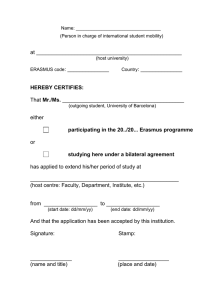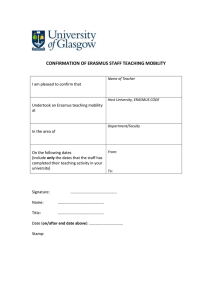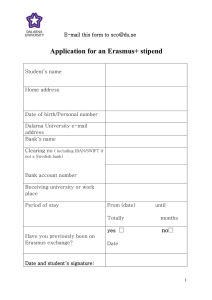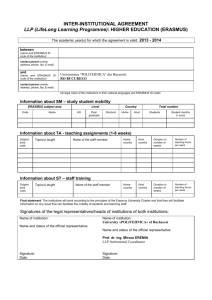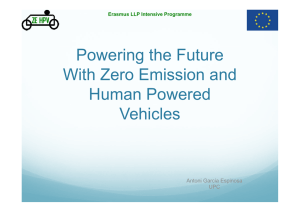Suspension system design (Paul Aisopoulos)
advertisement
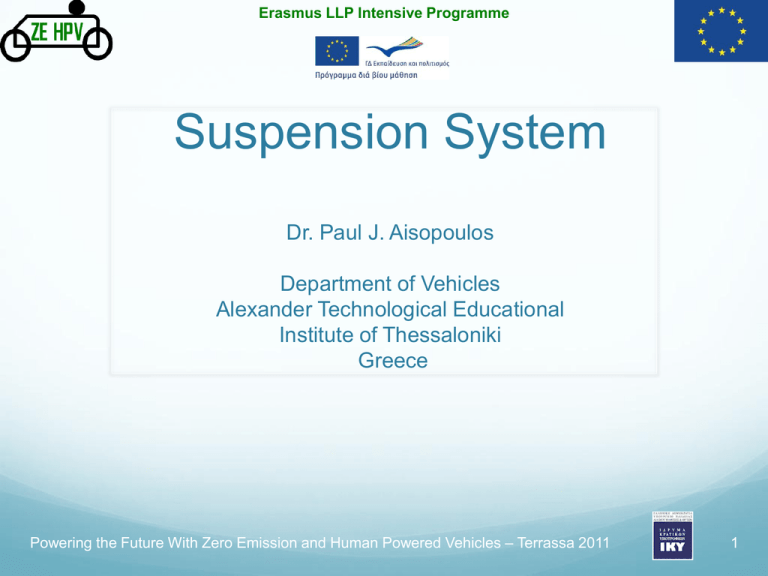
Erasmus LLP Intensive Programme Suspension System Dr. Paul J. Aisopoulos Department of Vehicles Alexander Technological Educational Institute of Thessaloniki Greece Powering the Future With Zero Emission and Human Powered Vehicles – Terrassa 2011 1 Erasmus LLP Intensive Programme Primary function of a suspension system Comfort Provide vertical compliance so the wheels can follow the uneven road, isolating the chassis from the roughness of the road. Safety React to the control forces produced by the tires longitudinal, lateral forces, braking and driving torques, in purpose to protect the passengers, the luggage and the suspension system itself. Handling Keep the tires in contact with the road with minimal load variations and resist roll of the chassis. Powering the Future With Zero Emission and Human Powered Vehicles – Terrassa 2011 2 Erasmus LLP Intensive Programme Suspension System Parts Mechanism Suspension System Spring Damper Powering the Future With Zero Emission and Human Powered Vehicles – Terrassa 2011 3 Erasmus LLP Intensive Programme Suspension System Mechanism Determines the suspension geometry and specifies the kinematics of the wheel points in the vertical and lateral movements. Prescribes the kinematic of the wheel relatively to chassis. The part on which the wheel and of the braking and steering system are installed. Linking mechanism of knuckle with the control arms. Supplementary units for absorbing the vibration. Powering the Future With Zero Emission and Human Powered Vehicles – Terrassa 2011 4 Erasmus LLP Intensive Programme Coil Spring Spring rate Gd4 k 64 i rm3 G: shear modulus of spring material. iεν: number of active coils of the spring. d: rm: wire diameter. average radius of the coils of the spring. Powering the Future With Zero Emission and Human Powered Vehicles – Terrassa 2011 5 Erasmus LLP Intensive Programme Equivalent Spring Rate Parallel springs keq k1 k2 Springs in series keq k1 k2 k1 k2 Spring with inclination keq k sin 2 Powering the Future With Zero Emission and Human Powered Vehicles – Terrassa 2011 6 Erasmus LLP Intensive Programme Rubber Spring Axial spring Ed Ad h Ed (4 7,5 c1.79 ) G E 2G (1 ) ka F Ad d d2 0.5(rubber ), c , Ad , A1 dh A1 4h 4 Shear Spring k F G Ad h Εd: Ιdeal elasticity modulus Αd: Cross section area h: Spring height G: Shear modulus of spring material Powering the Future With Zero Emission and Human Powered Vehicles – Terrassa 2011 7 Erasmus LLP Intensive Programme Damped spring and mass system Free Vibration Free body diagramm m: Inertial force FI m y Mass c: Damping coefficient k: Spring rate Spring force Damping force Fs k y Fd c y Equation of motion m y c y k y 0 0 y0 y (t ) e ( y0 cos d t sin d t ) d t v0 , y0 Initial conditions 2 Period Td d Powering the Future With Zero Emission and Human Powered Vehicles – Terrassa 2011 8 Erasmus LLP Intensive Programme Damped spring and mass system Free Vibration System parameters m: oUndamped natural frequency 0 k / m d 0 1 2 oDamping ratio c 2 k m oCritical damping coefficient Y Displacement oDamped natural frequency Mass c: Damping coefficient k: Spring rate 1 0.8 0.6 0.4 0.2 1E-16 -0.2 -0.4 -0.6 -0.8 -1 -1.2 crit 1 ccrit 2 k m c 0 0.5 1 1.5 ζ=0,1 ζ=0,4 ccrit Powering the Future With Zero Emission and Human Powered Vehicles – Terrassa 2011 2 ζ=1 2.5 3 t/T0 T0 2 0 9 Erasmus LLP Intensive Programme Forced Vibration (base excitation) Equation of motion m y c y k y cs ks s s0 s in(t ) 1 (2 ) 2 y Y s0 (1 2 ) 2 (2 ) 2 0 Frequency ratio Important designe parameters oResonant frequency oDamping ratio 0 k / m c 2 k m m: Mass c: Damping coefficient k: Spring rate s: Road input Powering the Future With Zero Emission and Human Powered Vehicles – Terrassa 2011 10 Erasmus LLP Intensive Programme Quarter-car modal ms: mus: Unsprung mass ks: Suspension stiffness cs: Suspension damping coefficient k t: Tire stiffness ys: Sprung mass displacement yus: Sprung Mass Sprung mass s: Unsprung mass displacement Road input Is the portion of the vehicle's total mass that is supported above the suspension. (chassis, engine, differential system, passengers, cargo-luggage) . Unsprung Mass Is the mass of the components suspended below the suspension (tire, control arms, braking system, etc). Powering the Future With Zero Emission and Human Powered Vehicles – Terrassa 2011 11 Erasmus LLP Intensive Programme Quarter-car modal Equations of motion ms ys cs ys cs yus ks ys ks yus 0 mus yus cs ys cs yus ks ys ( ks kt ) yus kt s ms 0 0 ys cs mus yus cs cs ys ks cs yus ks M y C y K y f , for undamped system k s ys 0 ks kt yus kt s y ( ys yus )T det( K M n2 ) 0 Undamped natural frequencies k s kt k s 2 4ks2 1 ks kt ks [ ( ) ] 2 mus ms mus ms ms mus 2 1,2 Ride Rate The effective stiffness of the suspension and tire springs in series keq Powering the Future With Zero Emission and Human Powered Vehicles – Terrassa 2011 k s kt k s kt 12 Erasmus LLP Intensive Programme Suspension stiffness Suspension stifness ks Ride rate Road amplitude increase at high frequencies Bounce natural frequency Keep ω0 as low as possible Lower suspension stiffness ks Higher ks elevate the frequency of the wheel hop to higher frequencies More acceleration transmission in high frequency rage •Keep the suspension soft for ride isolation •Frequencies (1 - 1.3 Hz) Powering the Future With Zero Emission and Human Powered Vehicles – Terrassa 2011 13 Erasmus LLP Intensive Programme Suspension Damping Low damping ratio ζ • (-) high vertical acceleration at low frequencies • (+) High attenuation at high frequencies For good ride Damping ratio ζ=0.2 - 0.4 Higher damping ratio values (-) higher vertical acceleration in high frequency range Damping ratio >1 •So stiff damper •the suspension no longer moves •Vehicle bounces on its tires. Powering the Future With Zero Emission and Human Powered Vehicles – Terrassa 2011 14 Erasmus LLP Intensive Programme Measurement of Damper Characteristics vD max n 60 (m / sec) FD c vDn FD: Damping force c: Damping coefficient vD: : n: velocity stroke rev speed Powering the Future With Zero Emission and Human Powered Vehicles – Terrassa 2011 15 Erasmus LLP Intensive Programme Quarter-car modal k1 k2 k1 2 4k12 1 k1 k2 k1 [ ( ) ] 2 m2 m1 m2 m1 m1m2 2 1,2 Powering the Future With Zero Emission and Human Powered Vehicles – Terrassa 2011 16 Erasmus LLP Intensive Programme Rigid Body motions Bounce/Pitch Combination of bounce and pitch determine the vertical and longitudinal vehicle vibrations. Depending on the rode and speed conditions, one or the other motions may be largly absent. Powering the Future With Zero Emission and Human Powered Vehicles – Terrassa 2011 17 Erasmus LLP Intensive Programme Bounce and Pitch vibration modes Equations of motion M z ( k f kr ) z ( kr a k f b) 0 I y ( kr a k f b) z ( kr a 2 k f b 2 ) 0 M 0 0 z k f kr kr a k f b z 0 I y kr a k f b kr a 2 k f b 2 0 M y C y K y 0, y ( z )T •for undamped system det( K M n2 ) 0 Undamped natural frequencies •for the case that α=b=wheel base/2 and kf=kr=k M z ( 2k ) z 0 b I y ( k 2 / 2) 0 2k , p M k 2 2I y f kf mf r kr mr The bounce and pitch modes are decoupled and pure bounce and pitch motions result. Powering the Future With Zero Emission and Human Powered Vehicles – Terrassa 2011 18 Erasmus LLP Intensive Programme Bounce and Pitch vibration modes Oscillation center (Z / )( ) 0 The center is ahead of CG by a distancex=z/θ (Z / )( ) 0 The center is behind the CG by a distancex=z/θ The center is outside the wheelbase bounce The center is within the wheelbase pitch The center location depends on the values of the natural frequencies ωf and ωr f r f r f r The center is at CG (decoupled motions) Bounce center ahead of the front axle Pitch center toward the rear axle(coupled motions) Bounce center behind the rear axle Pitch center forward near the front axle(coupled motions) Powering the Future With Zero Emission and Human Powered Vehicles – Terrassa 2011 19 Erasmus LLP Intensive Programme Design criteria b a W f W , Wr W the front suspension should have lower natural frequency The lower front to rear ratio of frequencies will tend to induce bounce Time lag between the axles t / v v: Car speed c: Wheelbase Powering the Future With Zero Emission and Human Powered Vehicles – Terrassa 2011 20
